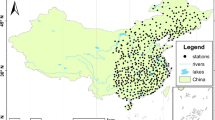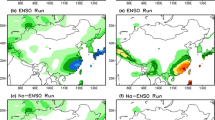Abstract
Changes of the frequency of precipitation extremes (the number of days with daily precipitation exceeding the 90th percentile of a daily climatology, referred to as R90N) in summer (June–August) over the mid-lower reaches of the Yangtze River are analyzed based on daily observations during 1961–2007. The first singular value decomposition (SVD) mode of R90N is linked to an ENSO-like mode of the sea surface temperature anomalies (SSTA) in the previous winter. Responses of different grades of precipitation events to the climatic mode are compared. It is notable that the frequency of summer precipitation extremes is significantly related with the SSTA in the Pacific, while those of light and moderate precipitation are not. It is suggested that the previously well-recognized impact of ENSO on summer rainfall along the Yangtze River is essentially due to a response in summer precipitation extremes in the region, in association with the East Asia-Pacific (EAP) teleconnection pattern. A negative relationship is found between the East Asian Summer Monsoon (EASM) and precipitation extremes over the mid-lower reaches of the Yangtze River. In contrast, light rainfall processes are independent from the SST and EASM variations.
Similar content being viewed by others
References
Allan, R. P., and B. J. Soden, 2008: Atmospheric warming and the amplification of precipitation extremes. Science, 321, 1481–1484.
Cayan, D. R., K. T. Redmond, and L. G. Riddle, 1999: ENSO and hydrologic extremes in the western United States. J. Climate, 12, 2881–2893.
Chang, C. P., Y. Zhang, and T. Li, 2000: Interannual and interdecadal variations of the East Asian summer monsoon and tropical Pacific SSTs. Part I: Roles of the subtropical ridge. J. Climate, 13, 4310–4325.
Fu, J. L., W. H. Qian, X. Lin, and D. L. Chen, 2008: Trends in graded precipitation in China from 1961 to 2000. Adv. Atmos. Sci., 25(2), 267–278, doi: 10.1007/s00376-008-0267-2.
Gershunov, A., and T. P. Barnett, 1998: ENSO influence on intraseasonal extreme rainfall and temperature frequencies in the contiguous United States: Observations and model results. J. Climate, 11, 1575–1586.
Gershunov, A., and D. R. Cayan, 2003: Heavy daily precipitation frequency over the contiguous United States: Sources of climatic variability and seasonal predictability. J. Climate, 16, 2752–2765.
Gong, D. Y., and C. Ho, 2002: Shift in the summer rainfall over the Yangtze River valley in the late 1970s. Geophys. Res. Lett., 29(10), 1436, doi: 10.1029/2001GL014523.
Gong, D. Y., and C. Ho, 2003: Arctic oscillation signals in the east Asian summer monsoon. J. Geophys. Res., 108(D2), 4066, doi: 10.1029/2002JD002193.
Goswami, B. N., V. Venugopal, D. Sengupta, M. S. Madhusoodanan, and P. K. Xavier, 2006: Increasing trend of extreme rain events over India in a warming environment. Science, 314, 1442–1445.
Grimm, A. M., and R. G. Tedeschi, 2009: ENSO and extreme rainfall events in South America. J. Climate, 22, 1589–1608.
Groisman, P. Y., and Coauthors, 1999: Changes in the probability of heavy precipitation: Important indicators of climatic change. Climatic Change, 42, 243–283.
Haylock, M. R., and C. M. Goodess, 2004: Interannual variability of European extreme winter rainfall and links with mean large-scale circulation. International Journal of Climatology, 24, 759–776.
Huang, R. H., and Y. Wu, 1989: The influence of ENSO on the summer climate change in China and its mechanism. Adv. Atmos. Sci., 6, 21–32.
Huang, R. H., and F. Sun, 1992: Impacts of the tropical western Pacific on the east Asian summer monsoon. J. Meteor. Soc. Japan, 70, 243–256.
Huang, G., and Z. Yan, 1999: The East Asian Summer Monsoon circulation anomaly index and its interannual variations, Chinese Science Bulletin, 44(4), 421–424. (in Chinese)
Kalnay, E., and Coauthors, 1996: The NCEP/NCAR 40-year reanalysis project. Bull. Amer. Meteor. Soc., 77, 437–471.
Katz, R. W., and B. G. Brown, 1992: Extreme events in a changing climate: Variability is more important than averages. Climatic Change, 21(3), 289–302.
Li, J., and Q. Zeng, 2002: A unified monsoon index. Geophys. Res. Lett., 29(8), 1274, doi: 10.1029/2001GL013874.
Liu, B. H., M. Xu, M. Henderson, and Y. Qi, 2005: Observed trends of precipitation amount, frequency, and intensity in China, 1960–2000. J. Geophys. Res., 110, D08103, doi: 10.1029/2004JD004864.
Moberg, A., and Coauthors, 2006: Indices for daily temperature and precipitation extremes in Europe analyzed for the period 1901–2000. J. Geophys. Res., 111, D22106, doi: 10.1029/2006JD007103.
Nitta, T., 1987: Convective activities in the tropical western Pacific and their impact on the Northern Hemisphere summer circulation. J. Meteor. Soc. Japan., 65, 373–390.
Qian, W. H., J. Fu, and Z. Yan, 2007: Decrease of light rain events in summer associated with a warming environment in China during 1961–2005. Geophys. Res. Lett., 34, L11705, doi: 10.1029/2007GL029631.
Qian, W. H., J. Zhu, Y. Wang, and J. Fu, 2009a: Regional relationship between the Jiang-Huai Meiyu and the equatorial surface-subsurface temperature anomalies. Chinese Sci. Bull., 54, 113–119. (in Chinese)
Qian, Y., D. Gong, J. Fan, L. R. Leung, R. Bennartz, D. Chen, and W. Wang, 2009b: Heavy pollution suppresses light rain in China: Observations and modeling. J. Geophys. Res., 114, D00K02, doi: 10.1029/2008JD011575.
Smith, T. M., R. W. Reynolds, T. C. Peterson, and J. Lawrimore, 2008: Improvements to NOAA’s historical merged land-ocean surface temperature analysis (1880–2006). J. Climate, 21, 2283–2296.
Wallace, J. M., C. Smith, and C. S. Bretherton, 1992: Singular value decomposition of wintertime sea surface temperature and 500-mb height anomalies. J. Climate, 5, 561–576.
Wang, B., R. Wu, and X. Fu, 2000: Pacific-East Asian teleconnection: How does ENSO affect East Asian climate? J. Climate, 13, 1517–1536.
Wang, X. L., and V. R. Swail, 2001: Changes of extreme wave heights in Northern Hemisphere oceans and related atmospheric circulation regimes. J. Cli mate, 14, 2204–2221.
Wang, Y., and L. Zhou, 2005: Observed trends in extreme precipitation events in China during 1961–2001 and the associated changes in large-scale circulation. Geophys. Res. Lett., 32, L09707, doi: 10.1029/2005GL022574.
Wang, Y., and Z. Yan, 2009: Trends in seasonal precipitation over China during 1961–2007. Atmos. Oceanic Sci. Lett., 2, 165–171.
Wu, R., and B. Wang, 2002: A contrast of the East Asian summer monsoon-ENSO relationship between 1962–77 and 1978–93. J. Climate, 15, 3266–3279.
Wu, R., and B. P. Kirtman, 2007: Observed relationship of spring and summer East Asian rainfall with winter and spring Eurasian snow. J. Climate, 20, 1285–1304.
Wu, R., Z.-Z. Hu, and B. P. Kirtman, 2003: Evolution of ENSO-related rainfall anomalies in East Asia. J. Climate, 16, 3742–3758.
Yan, Z., S. Bate, R. Chandler, V. Isham, and H. Wheater, 2002: An analysis of daily maximum windspeed in northwestern Europe using Generalised Linear Modelling. J. Climate, 15(15), 2073–2088.
Yan, Z., and C. Yang, 2000: Geographical patterns of extreme climate changes in China during 1951–1997. Climatic and Environmental Research, 5(3), 267–272. (in Chinese)
Yao, C., W. Qian, S. Yang, and Z. Lin, 2009: Regional features of precipitation over Asia and summer extreme precipitation over Southeast Asia and their associations with atmospheric-oceanic conditions. Meteor. Atmos. Phys., 106(1), 57–73.
Zhai, P., X. Zhang, H. Wan, and X. Pan, 2005: Trends in total precipitation and frequency of daily precipitation extremes over China. J. Climate, 18, 1096–1108.
Zhang, R. H., A. Sumi, and M. Kimoto, 1999: A diagnostic study of the impact of El Niño on the precipitation in China. Adv. Atmos. Sci., 16, 229–241.
Zhang, X., W. D. Hogg, and É. Mekis, 2001: Spatial and temporal characteristics of heavy precipitation events over Canada. J. Climate, 14, 1923–1936.
Zhou, T., and R. Yu, 2005: Atmospheric water vapor transport associated with typical anomalous summer rainfall patterns in China. J. Geophys. Res., 110(D8), D08104.
Author information
Authors and Affiliations
Corresponding author
Rights and permissions
About this article
Cite this article
Wang, Y., Yan, Z. Changes of frequency of summer precipitation extremes over the Yangtze River in association with large-scale oceanic-atmospheric conditions. Adv. Atmos. Sci. 28, 1118–1128 (2011). https://doi.org/10.1007/s00376-010-0128-7
Received:
Revised:
Published:
Issue Date:
DOI: https://doi.org/10.1007/s00376-010-0128-7




